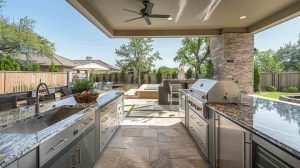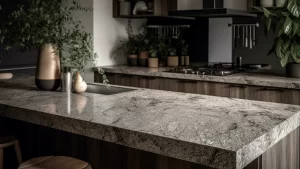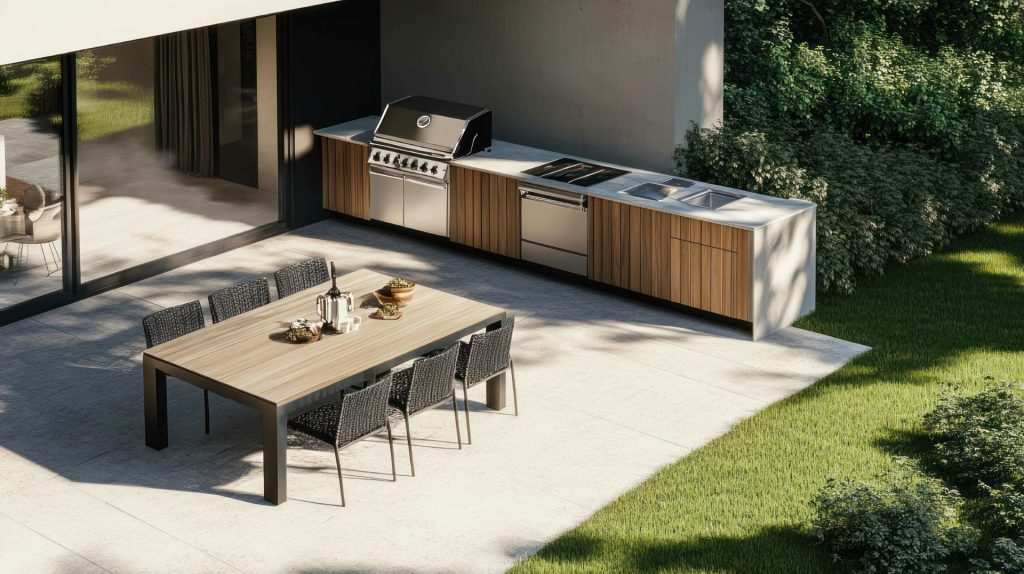The idea of outdoor kitchens is no longer just a Mediterranean luxury — more and more UK homeowners are investing in stylish, functional outdoor cooking spaces.
Whether it’s for summer barbecues, alfresco dining or simply adding value to a property, an outdoor kitchen offers a unique blend of practicality and pleasure.
But to make the most of it year-round, especially in the unpredictable British weather, the right materials are key.
Stone surfaces are fast becoming the preferred choice due to their durability, natural beauty, and resistance to weather extremes. However, not all stone is created equal, and outdoor use demands careful selection.
In this post, we’ll explore the best stone features that can withstand the UK’s challenging climate while keeping your outdoor kitchen looking stunning for years to come.
Understanding the UK Climate
British weather is notoriously varied, with rain, frost, wind, and occasional heatwaves all making appearances — often in the same week. These conditions place significant strain on outdoor surfaces.
Materials used outdoors must cope with moisture, freeze-thaw cycles, and UV exposure without becoming damaged or discoloured.
If unsuitable surfaces are used, you may face issues like cracking, warping, moss growth, or staining. This is especially true in outdoor kitchens, where food preparation and heat sources also come into play.
Choosing stone that is hard-wearing, weather-resistant, and easy to maintain ensures your kitchen remains functional and attractive in all seasons.

Best Stone Materials for British Outdoor Kitchens
Granite is one of the most popular choices for outdoor kitchens in the UK — and with good reason. It’s incredibly tough, naturally resistant to water, and handles both heat and cold with ease.
A flamed or leathered finish adds extra grip and texture, making it ideal for wet conditions while also enhancing its rustic charm.
Porcelain is another strong contender, especially for those seeking a modern, minimalistic finish. It’s non-porous, UV-resistant, and highly scratch-proof, which makes it a perfect option for outdoor countertops and cladding.
As it doesn’t absorb moisture, it’s also resistant to frost damage, making it ideal for our damp climate.
Quartzite — not to be confused with engineered quartz — is a natural stone that blends elegance with strength.
It boasts rich veining similar to marble, but with much better resistance to heat and water. This makes it a stunning choice for outdoor kitchens that aim to impress without compromising on durability.
It’s worth noting that traditional quartz, commonly used indoors, is not suitable for outdoor use in the UK.
The resins used in engineered quartz are prone to discolouration and damage when exposed to direct sunlight and variable temperatures. For this reason, it’s best to opt for natural alternatives for exterior spaces.
Finishing Touches for All-Weather Functionality
The finish of your stone surface plays a vital role in how well it copes outdoors. For outdoor kitchens, textured finishes like honed, flamed, or leathered are recommended, as they offer better slip resistance and hide weathering more effectively.
A polished surface may look sleek, but it’s more prone to becoming slippery when wet and can show signs of wear faster.
Drainage is also key when designing an outdoor space. Ensure your worktop layout allows for easy water runoff, and consider sloping surfaces slightly away from high-traffic areas.
Incorporating features like integrated stone sinks and upstands can improve both hygiene and aesthetics, offering a seamless look that stands up to the elements.
Maintenance Tips for Outdoor Stone
Even the most durable stone will benefit from a little routine care. Sealing natural stone annually can help prevent stains, algae build-up, and water absorption.
This is especially important in wetter regions of the UK, where prolonged damp conditions can accelerate wear.
Regular cleaning with pH-neutral stone cleaners will keep surfaces looking fresh without damaging the finish.
Avoid using bleach or acidic products, as they can erode the sealant or dull the stone over time. Covering your outdoor kitchen in winter or when not in use for long periods can also help prolong its life.

Design Considerations for a Cohesive Look
Choosing stone that complements your garden, patio or home exterior can tie the whole space together beautifully.
Matching your worktop to stone paving or using the same material for cladding walls can help create a cohesive, high-end look. Alternatively, contrasting colours and textures can be used to define different zones within the outdoor kitchen.
Outdoor kitchens are about more than just practicality — they’re about creating spaces that invite you to enjoy the outdoors. Combine your stone surfaces with features like pergolas, fire pits, or overhead heating to make the area usable even during the cooler months.
This way, your investment becomes a space that can be enjoyed throughout the year, not just in summer.
Conclusion
The British climate may be unpredictable, but that doesn’t mean your outdoor kitchen has to be.
With the right choice of stone — whether it’s granite, porcelain, or quartzite — you can enjoy a beautiful and long-lasting space that’s ready for anything the weather throws at it.
Whether you’re starting from scratch or upgrading an existing setup, Stone Connection offers expert advice and high-quality stone to help bring your outdoor vision to life.
Get in touch with our team to find the perfect surface for your outdoor kitchen today.

